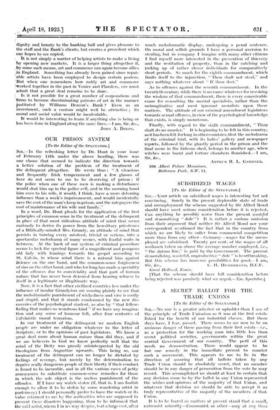COMMERCE AND ART: A BANK'S EXAMPLE [To the Editor of the SPECTATOR.]
Sus,--In several articles in the Spectator recently I have been much interested to find references to the changing position of the artist in our social structure. It is certainly true that private patrons and collectors of paintings are diminishing in number, partly because the means of the old patron class are restricted but more because wall-space for pictures is even more restricted in modern houses. The art gallery, like the museum, is certainly less beloved of this generation than in Victorian and Edwardian days.
For this reason I imagine your readers will be interested to, hear of the admirable example set by the Williams Deacon's Bank in deciding to decorate the interior of their new premises in Pall Mall not with marble facings, but with a collection of etchings of London by living artists. Through the courtesy ; of Mr. Newman, the manager, I have seen these etchings.The Bank is to be congratulated onhaving accepted the services of Mr. Muirhead Bone, the artist, to select and hang suitable pictures, of which there are about twenty. All are works of serious merit ; one is perhaps most arrested by the "Piccadilly Circus" of Mr. Randolph . Schwabe, and the . " Vcrrey's " of Mr. Maresco Pearce, because the modes for, these are already things. vanished, but Mr. Ian . Strang's ", Cannon Street Station ". is a particularly happy piece of • work. The .presence of. these . fine etchings not :only lends
dignity and beauty to the banking hall and gives pleasure to the staff and the Bank's clients, but creates a precedent which one hopes to see copied.
It is not simply a matter of helping artists to make a living by opening new markets. It is a larger thing altogether if, by some such means, art and commerce can again become allies tin England. Something has already been gained since reput'able artists have been employed to design certain posters. But when one remembers how nobly art and commerce 'rworked together in the past in Venice and Flanders, one must admit that a great deal remains to be done.
Is it not possible for a great number of corporations and 'firms to become discriminating patrons of art in the manner instituted by Williams Deacon's.. Ban,k ? Even as an investment, such a custom might well be attractive ; its moral and social valtie would be incalculable.
It would be interesting to learn if anything else is being or has been done in England along the samt lines.—I am, Sir, &c., JOHN A. Dixox.











































 Previous page
Previous page